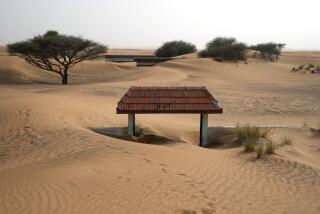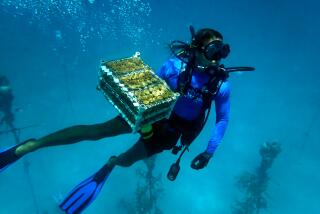Gulf’s Environment Imperiled by Ambitious Development
- Share via
DUBAI, United Arab Emirates — Stroll on Dubai’s shore and dead coral crunches underfoot. The normally crystal-clear Gulf is fogged with silt. Eroding beaches need truckloads of sand to stay in place.
The $14-billion manmade islands project that is luring buyers from around the world is also damaging the habitat for Gulf marine life.
The new land masses have buried coral reefs, oyster beds and sea grasses that nurtured fish and sea turtles. They block and reroute natural currents, eroding Dubai’s famous natural beaches.
One of the archipelagoes, the Palm Jebel Ali, lies in an area once protected as a marine wildlife zone.
Government-controlled developer Nakheel acknowledges that its projects have covered reefs and altered the environment, and says it is trying to counteract some of the damage. Once work is finished, sea life will thrive on the islands’ artificial reefs, said Imad Haffar, Nakheel’s research and development manager.
But the environment will never be the same, said Frederic Launay, director of the Abu Dhabi office of the World Wide Fund for Nature.
“If you build stretches of five-star hotels with landscaped gardens, you’re transforming a wild environment to an urban environment,” Launay said. “There will be different species. It’s an artificial system.”
Divers and environmentalists say construction dredges have stirred up so much silt that coral reefs and other creatures are being asphyxiated or chased away. The silt has ruined Dubai’s diving -- at least temporarily.
“Visibility is zero,” said Ibrahim Zu’bi of the Emirates Diving Assn.
Zu’bi said he dived on an oyster bed off Dubai in February and found it covered by more than two inches of silt. Divers have abandoned Dubai’s waters for cleaner environs on the Gulf of Oman, he said.
Haffar said that the silting is temporary and that once the sea clears, Nakheel will seek to resurrect diving opportunities around its palm islands. The company hired a marine biologist to try to rejuvenate suffering coral, he said.
David Bellamy, a British conservationist and TV documentary host, said after touring a Palm construction site that it was “like watching Venice being built.” He agreed that rubble dumped to create the islands would provide cover for fish.
“If they do it right, with proper effluent treatment, there will be a lot of new habitat,” he said.
More to Read
Sign up for Essential California
The most important California stories and recommendations in your inbox every morning.
You may occasionally receive promotional content from the Los Angeles Times.










